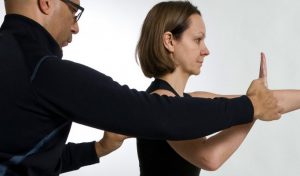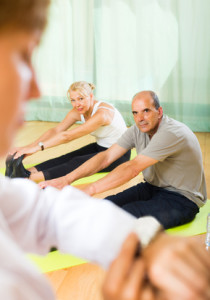 Early in my career I was taught that everyone is an athlete and therefore should be trained as an athlete. While I had some success using this approach I quickly recognized that many of my clients, especially my older clients, were not improving and some were even regressing – losing mobility and developing overuse type injuries. I was quite discouraged with my results and turned my attention to working with younger individuals – simply, because they were easier to work with.
Early in my career I was taught that everyone is an athlete and therefore should be trained as an athlete. While I had some success using this approach I quickly recognized that many of my clients, especially my older clients, were not improving and some were even regressing – losing mobility and developing overuse type injuries. I was quite discouraged with my results and turned my attention to working with younger individuals – simply, because they were easier to work with.
However, life has a funny way of aligning one with where one needs to go. As my client list grew, the average age of the individuals being referred to me also kept increasing and the issues they presented with were generally fairly involved:
- Degenerative joint disease
- Chronic tightness and discomfort
- Joint replacements and surgeries– especially of the hips, knees, and low back
I recognized that despite all my training in chiropractic school and years of working as a fitness professional, I was not adequately prepared to work with this population. This forced me to start closely evaluating my clients and the programs I was using with them.
If you work with the older population you are well aware that training these individuals is not the same as training athletes. While older clients also have very specific goals and are highly motivated to achieve them, they generally present with a more significant medical history, have more chronic postural and movement issues that affect how they perform, and do not respond as quickly as younger individuals.
The great news is that fitness professionals who understand the nuances of working with this population can design safe and effective programs to help these individuals achieve their health and fitness goals and will be in high demand in the coming years. However, because of their unique needs, you must have a foundation to be successful.
The Three Keys to Effectively Training the Older Adult
Having worked primarily with older adults for the past 20 years has provided me with a unique perspective into training this population. Studying everything I could about working with older adults and combined with plenty of input and feedback from my clients themselves, we have developed a very specific corrective exercise strategy at our clinic, one that has given us a framework for success regardless of how complicated the individual’s history or level of conditioning.
There are three keys we have found to be fundamental in helping improve the effectiveness of my training programs and help our older clients successfully work towards accomplishing their health and fitness goals. These 3 concepts form the foundation of our Integrative Corrective Exercise Strategy™.
1. Awareness
One of our primary goals when training the older client is to help them identify or become aware of the factors that are within their control that both directly and dramatically affect their health. Too many of our older clients have been told that they have bad genetics, or that they are simply ‘too old’ to make changes and simply relegate themselves to their current health status. It is our job to educate and empower our clients to take control of the factors that are within their control – for example, how they move, how they exercise, how they sleep, and how they eat are all factors within their control. Empower your clients – as well as potential clients – to take control of the factors that have both a direct and dramatic impact on their health and fitness.
The other component of awareness is your client’s habits. Our older clients have developed habits that dictate how they stand, sit, and move. These habits have been influenced by their medical history (traumas, injuries, surgeries), medications, occupation, level of activity and/or inactivity, beliefs, etc. The most important component to our corrective exercise program is to help increase our client’s awareness of where their body is in space as well as how to move efficiently as they are able so they can develop more optimal posture and movement habits.
2. Attention-to-detail
The next most important component of how we use corrective exercise is attention-to-detail or paying attention to the simple things that can be often over-looked. Things like helping clients position their body a bit differently to reduce joint stress, choosing an exercise that allows the client to be successful versus one that overloads their joints, paying attention to how the client is breathing, and providing them with an improved strategy are some of the simple things that ultimately can have a dramatic impact upon their overall success.
3. Appropriate Progressions
The biggest challenge we see when consulting with health and fitness professionals who are having challenges with training their older clients is that they are using exercise progressions that are far too advanced for their client’s current level of conditioning. Using patterns that are too advanced will perpetuate your clients current posture and movement habits since they will default to their habitual postural, stabilization, and movement strategies when the pattern becomes too challenging and/or they fatigue. This in turn will perpetuate chronic tightness, discomfort, and/or decreased performance.
There is nothing wrong with pushing your client…as long as they’ve ‘earned-the-right’ or been progressed appropriately to successfully perform the higher-level intensity or patterns. Just as we ‘earned-the-right’ by successfully passing our course work to progress from grammar school, to high school, to college, clients ‘earn-the-right’ by successfully progressing from lower level patterns to more advanced levels and intensities.
In conclusion, you understand that training older clients is not like training athletes. While their goals are as significant to them as the athletes, the manner in which we approach their training cannot be the same as when training athletes.
By helping our older clients become aware of the factors that are within their control and helping them become more aware of their posture and movement we empower them for success.
By paying attention to the simple things like alignment, breathing, and control we can help our older clients address many of the underlying issues that are leading to chronic tension, discomfort, and/or the loss of performance.
By helping our clients ‘earn-the-right’ by appropriately progressing their patterns we empower them to safely and effectively work towards achieving their health and fitness goals.
Dr. Evan Osar is the developer of the Integrative Movement Specialist™ certification designed specifically to aid the fitness professional establish themselves as an invaluable part of their client’s health care team. He is the founder of Fitness Education Seminars, an education company with the mission of helping trainers and therapist recognize their role as a part of the solution to the health care crisis.


